S&P Global Offerings
Featured Topics
Featured Products
Events
S&P Global Offerings
Featured Topics
Featured Products
Events
S&P Global Offerings
Featured Topics
Featured Products
Events
Banking & Capital Markets
Economy & Finance
Energy Transition & Sustainability
Technology & Innovation
Podcasts & Newsletters
Banking & Capital Markets
Economy & Finance
Energy Transition & Sustainability
Technology & Innovation
Podcasts & Newsletters
S&P Global Offerings
Featured Topics
Featured Products
Events
Research — March 25, 2025
By Michael Johnson
March is a thrilling time for college basketball, captivating sports fans nationwide. The men's tournament, known for its rich history and dramatic upsets, attracts millions of viewers, while the women's tournament has gained significant popularity thanks to star players like Caitlin Clark. March Madness is also big business for the National Collegiate Athletics Association (NCAA), generating approximately $1 billion annually in revenue from media rights, licensing, ticket sales, and corporate sponsorships and advertising.

➤ The NCAA's current men's media rights agreement, resulting from an extension in 2016, is valued at almost $9 billion for the next eight years.
➤ The women's tournament has seen a remarkable increase in viewership, with the 2024 championship surpassing the men for the first time.
➤ Women's regular-season ESPN viewership rose 3% from last year's record, up 41% from the 2022–23 season.
➤ The total amount wagered on the 2024 March Madness tournaments reached almost $3 billion.

Current March Madness media rights deals set until 2032
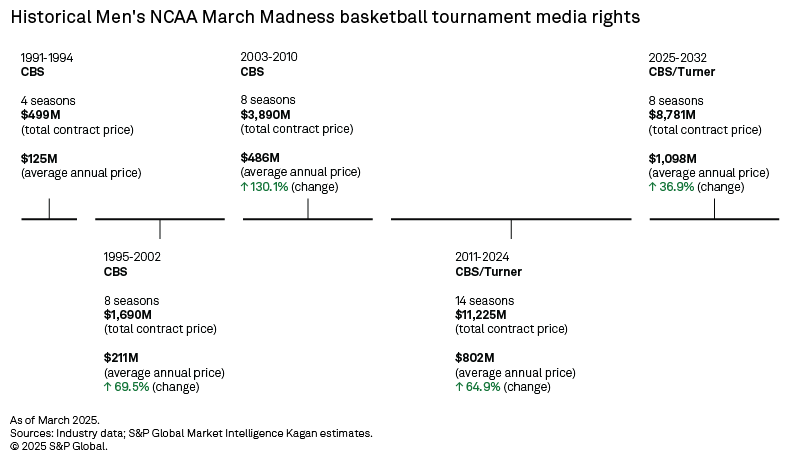
The NCAA secured its first agreement over $1 billion in 1994 with an eight-year deal with CBS (US), the men's tournament broadcaster since 1982, valued at approximately $1.69 billion. This upward trend continued with a landmark 14-year deal worth over $11 billion in 2010, marking the first partnership between CBS and Turner. Originally set to end in 2024, this deal was extended in 2016, adding another eight years and $8.78 billion to the agreement.
The NCAA's current media rights pact will last until 2032, which is impressive in a rapidly changing media landscape where sports entities are securing profitable deals at an unprecedented pace. As major leagues have recently achieved substantial rights increases, the NCAA's existing agreement appears to be a bargain, allowing its leaders to watch the market dynamics unfold to potentially set up a lucrative extension, or new deal entirely, in the near future.
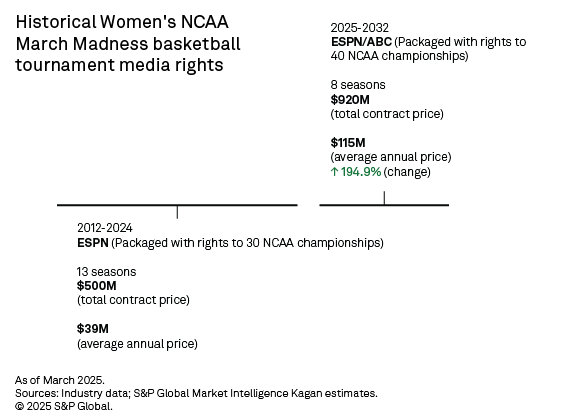
Over the past 13 seasons, ESPN (US) has averaged nearly $40 million annually for a package of media rights to various NCAA championships, including the women's March Madness tournament. In 2021, the NCAA received backlash for disparities between the men's and women's events. To address these issues, it revamped the women's tournament by introducing a First Four, branding it with March Madness, and enhanced funding and staffing. They also committed to developing a new media-rights strategy that accurately reflected the tournament's value.
Viewership increased greatly in 2023. In the following offseason, the NCAA negotiated a new media contract for all championships excluding the men's tournament and College Football Playoff, securing $920 million over eight years for 40 championships. This package reportedly values the women's basketball tournament at $65 million annually, double its previous valuation.
The men's Final Four returns to San Antonio for the fifth time, while the women travel to Tampa
CBS Sports and TNT (US) Sports will deliver live coverage of all 67 games from the 2025 men's tournament across four major television networks: TBS (US), CBS, TNT and truTV (US). Fans can also stream all games on NCAA March Madness Live, with additional streaming available on Max for games broadcast on TBS, TNT and truTV. For those watching games on CBS, live streaming will be accessible through Paramount Global's Paramount+.
Throughout the tournament, CBS will broadcast a total of 24 games, featuring key matchups such as the national championship, Final Four semifinals, Elite Eight, Sweet 16, and the first and second rounds. TBS will air 18 games, including the Elite Eight, Sweet 16, and the first and second round contests. TruTV will provide coverage and simulcast 21 games, which encompasses the First Four games, as well as the Elite Eight, Sweet 16, and first and second rounds. Meanwhile, TNT will televise 12 games, focusing on the First and Second round matchups.
Also of scheduling note, the start time of men's national championship game has been moved up by 30 minutes this year from 9:20 p.m. EST to 8:50 p.m. EST. This change is a welcome development for many, as the game has often exceeded two hours, frequently running close to midnight in the Eastern time zone.
Walt Disney Co. will air live coverage of all 67 games from the women's tournament across the ESPN family of networks, kicking off with Selection Sunday on March 16.
Stars driving record-setting viewership for the women's tournament, as the men remain consistent
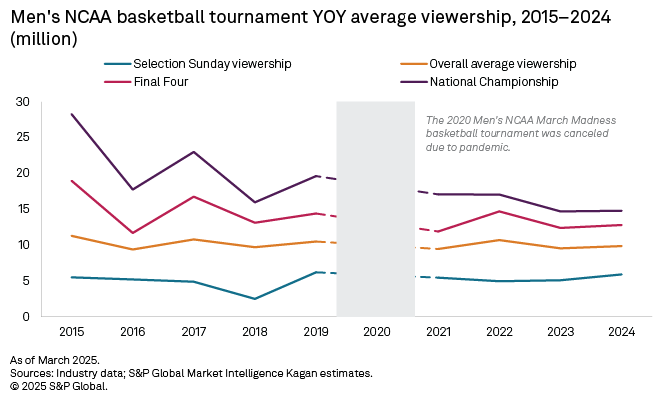
The 2015 men's March Madness was the most watched most-watched NCAA tournament since the mid-1990s, and since then, viewership totals have averaged slightly less each year. Since the tournament resumed following 2020's cancellation due to the pandemic, the tournament has averaged just under 10 million viewers overall, with the Final Four averaging 13 million. The four national championship games since 2020 have averaged 15.9 million viewers, down 5 million viewers on average when compared to the five championship games prior to the pandemic.
Since 2021, the men's March Madness tournament has consistently boosted prime-time viewership for TBS and truTV. March has become TBS's most-watched month in two of the last four years, while truTV has enjoyed its most-viewed month for four consecutive years.
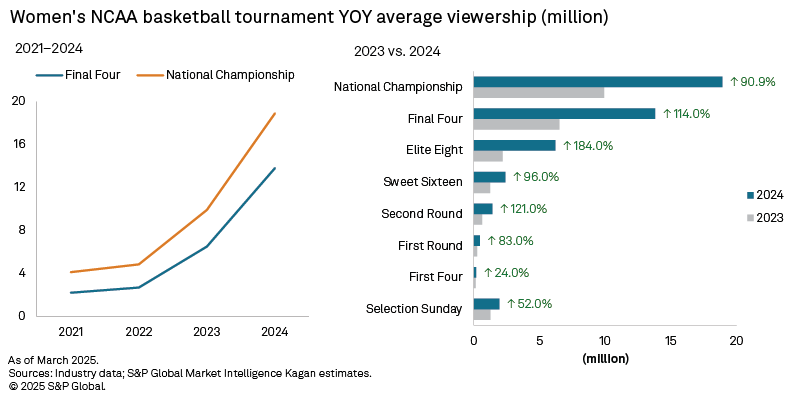
The women's NCAA tournament has experienced a surge in popularity, significantly driven by the rising stardom of Caitlin Clark. In recent years, viewership numbers have soared, culminating in a historic milestone last year when the NCAA women's college basketball championship attracted an average of 18.9 million viewers, surpassing the men's championship for the first time. The 2024 NCAA women's Final Four also achieved unprecedented viewership, up 114% to a record average of 13.8 million viewers, making it the most-watched women's Final Four in history.
ESPN has already reported a significant increase in regular-season viewership for women's college basketball, rising 3% from last year's record and 41% from the 2022–23 season. The 2024–25 ratings are the highest since the 2008–09 season.
However, it will be a challenge to replicate last year's March Madness viewership success as Caitlin Clark and others have transitioned to the WNBA. This year's Big Ten tournament final between UCLA and USC attracted 1.4 million viewers on CBS, making it the second-most-watched title game after last year's matchup, which drew 3.0 million. Meanwhile, the SEC championship game between South Carolina and Texas averaged 1.3 million viewers on ESPN, also the second highest behind last year's game that had 2.0 million viewers. Despite significant year-over-year declines (Big Ten down 52%, SEC down 35%), both games saw increases compared to their 2023 counterparts (Big Ten up 93%, SEC up 50%), highlighting the lasting impact of star players in 2024.
Who is watching March Madness?
Data from the S&P Global Market Intelligence Kagan Consumer Insights surveys for the third quarter of 2023 and the first quarter of 2024 indicated that 17% of internet adults watched NCAA men's college basketball last fall, rising to 20% as March Madness 2024 approached. Similarly, viewership for women's college basketball increased from 7% in fall 2023 to 9% in March 2024. Notably, 78% of those who watch women's NCAA games also follow men's games, while about 36% of men's college basketball viewers also watch women's games.
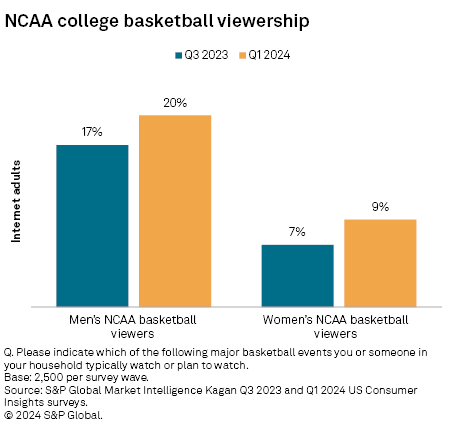
Approximately 20% of viewers for both NCAA men's and women's basketball are young adults under 35 years of age. One-third of the audience falls within the 35-54 age range, while around 45% are adults over 55. Gender demographics reveal that 70% of NCAA men's basketball viewers are male, compared to 62% of NCAA women's basketball viewers.
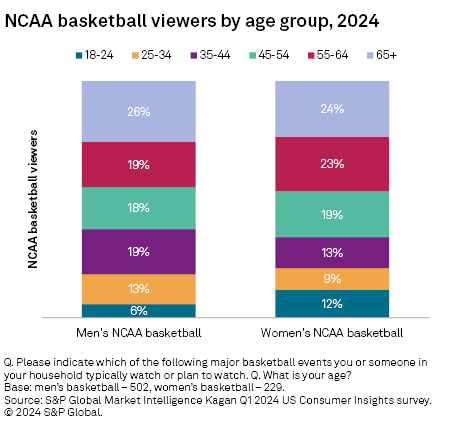
Billions are wagered on March Madness, exceeding Super Bowl betting totals during the tournaments
The American Gaming Association (AGA) reported that a record 68 million Americans placed bets in some form on March Madness in 2023. Of these, 31 million engaged in traditional betting online, at sportsbooks, or with bookies, while 21.5 million participated in casual bets with friends. Overall, 25% of American adults placed bets on the NCAA Tournament, a trend largely driven by the expansion of legalized sports betting.
In 2024, US bettors legally wagered a total of $2.7 billion on the NCAA basketball tournament, encompassing both men's and women's events. This amount is more than double compared to the $1.4 billion legally wagered on February's Super Bowl LIX between the Chiefs and Eagles.
As viewership for women's March Madness has soared, so has betting activity, with last year's tournament seeing a remarkable 190% increase in bets year-over-year at a notable sportsbook. The national championship emerged as the most-bet women's sporting event in history, drawing 205% more bets than the previous year's title game.
In our previously mentioned S&P Global Market Intelligence Kagan Consumer Insights survey, about 10% of March Madness viewers said they place bets on college basketball games.
Over 50 million participate in bracket contests, and it is likely that we will never witness perfection
Around 100 million brackets are filled out for March Madness each year, equating to one bracket for about 30% of the US population, including those who enter multiple times. The AGA estimates that about 56 million individuals participate in bracket contests.
The odds of creating a perfect bracket for the men's tournament are estimated at about one in 120 billion using strategic logic of selecting favorites and underdogs. The closest attempt at perfection reportedly occurred in 2019 when a bracket remained flawless through the first 49 games but ultimately failed. No perfect brackets survived the first round of the 2024 tournament, as No. 8 Utah State's victory over No. 9 TCU eliminated the last remaining perfect bracket.
This article was published by S&P Global Market Intelligence and not by S&P Global Ratings, which is a separately managed division of S&P Global.
Economics of Networks is a regular feature from S&P Global Market Intelligence Kagan.
